- Vaccine hopes instilled confidence, while “pandemic stocks” led the rally
- Italian-German yield spread narrows, but German bonds also advance
- NASDAQ indices score new records
Key Events
After EU negotiations on an economic recovery spending plan were finalized on Tuesday, US futures for the S&P 500, Dow Jones, NASDAQ and Russell 2000 all pushed higher, along with global stocks. The boost extended yesterday’s rally which was triggered by AstraZeneca's promising results for a COVID-19 vaccine in early human trials.
Nevertheless, the euro was flat and German Bunds rose for a second day.
Global Financial Affairs
We've frequently noted the contradictory narratives driving markets. Today’s dichotomy: risk sentiment has been buoyed by hopes for a vaccine, even though this rally is being led by tech stocks, which benefit from the stay-at-home environment generated by the coronavirus pandemic.
If investors were to actually think it through, rather than betting on tech shares while banking on an end to the virus, they'd be better served by snapping up downtrodden value stocks. But then how often are markets—and their participants—actually rational?
This morning, contracts on the four major US indices were up at least half-a-percent, with those on the Russell up more than 1.2% at time of writing.
S&P 500 futures climbed after the benchmark index turned positive for the year. It was the contract’s third day of gains, bringing it to the highest point since Feb. 21, the Friday before the panicked coronavirus selloff occurred.
Futures on the NASDAQ built on the record high hit yesterday by the underlying index, spurred by the return of investor appetite for companies that will profit during a pandemic.
Tech shares were also responsible for today's rally of Europe's STOXX 600. The pan-European index hit a four-and-a-half month high, helped by auto shares as well, which pushed the benchmark to a higher open.
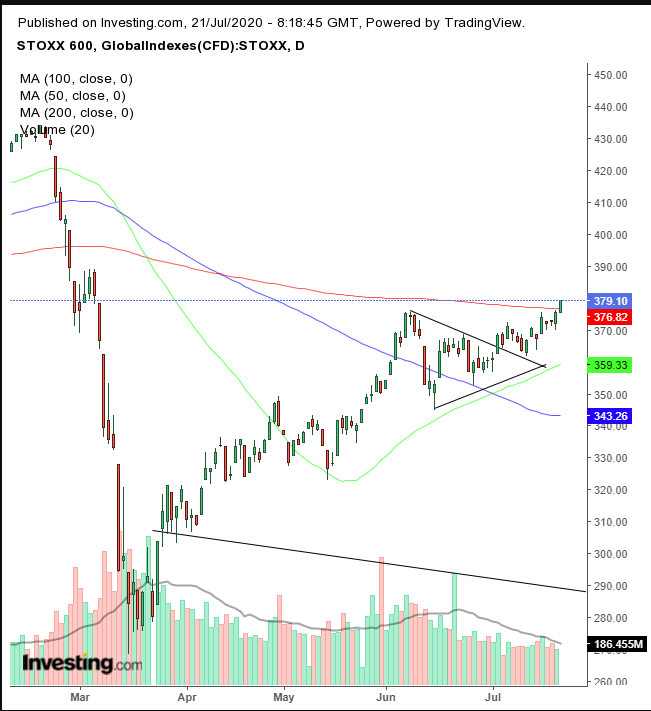
The pan-European benchmark crossed the 200 DMA—after completing a bullish pennant—for the first time since falling below it amid the virus selloff. Conversely, volume has been shrinking, a lack of participation that could undermine this rally.
Italian bonds climbed on the EU's summit deal, with the 10-year yield spread over the German equivalent, a key indicator of risk in the region, declining six basis points to 151, the lowest level since February.
On the other hand, demand for German Bunds increased, pushing yields down for a second day.
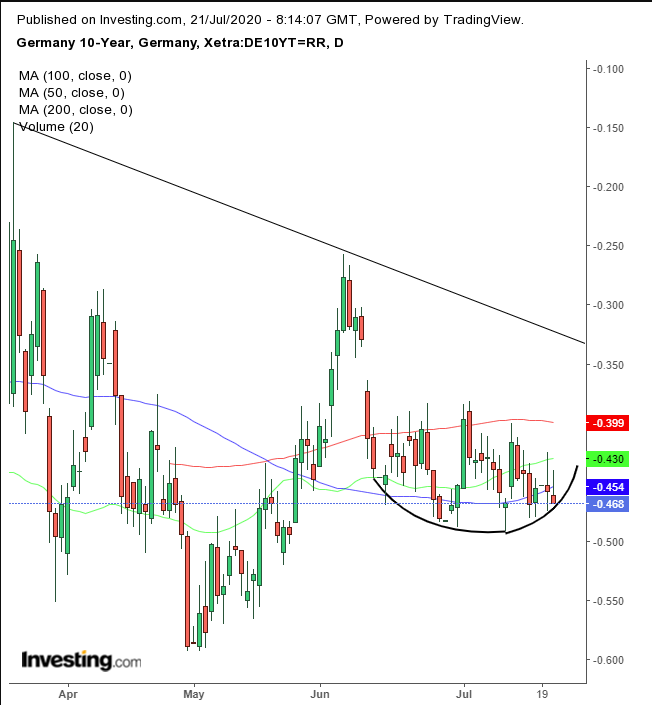
Thus, in comparison to the riskier Italian bonds, Germany's bonds gained, pushing yields lower, retesting a trading pattern, whose downside breakout would suggest a continued downtrend—a signal that investors are hedging against rising stocks.
As investors continue their search for safety, even while driving equities higher, Australian bonds have become a surprisingly good option.
Earlier today, Asian shares followed yesterday's Wall Street’s tech rally higher with all regional indices finishing in the green.
Australia’s ASX 200 outperformed, (+2.6%). It was the benchmark’s best session since June 16, after the country’s central bank advocated for further fiscal stimulus, boosting demand for riskier assets.
On Monday, US equities rallied to their highest since Feb. 24, after the S&P 500 plunged 3.3% on the first day of the virus-related selloff. Both the NASDAQ Composite and NASDAQ 100 hit new records, led by what are rapidly becoming the pandemic go-to stocks: Amazon (NASDAQ:AMZN) and Zoom (NASDAQ:ZM).
Shares of pharmaceuticals giant AstraZeneca (NYSE:AZN) jumped to a record high after the publication of results from its trial of a COVID-19 vaccine, but the rally faded after analysts said the data, while good, wasn’t as stellar as had been hoped.
Yields, including for the US 10-year Treasury note, were flat and the dollar may have found its footing.
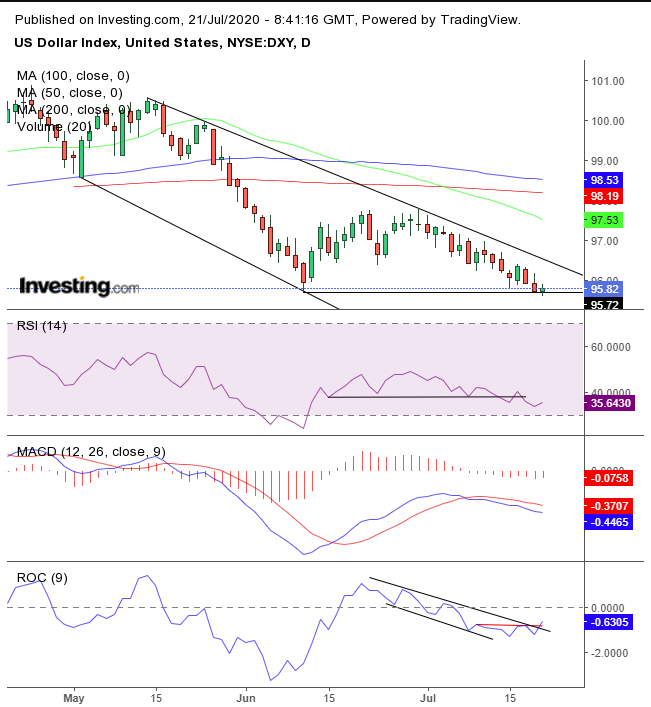
The USD confirmed yesterday’s inverted hammer after Wednesday’s hammer above the June 10 low. While the RSI and MACD are falling, the sensitive ROC may be turning around, suggesting the price may retest the top of a falling channel, which caused a Death Cross earlier in the month.
Gold is climbing for a third day.
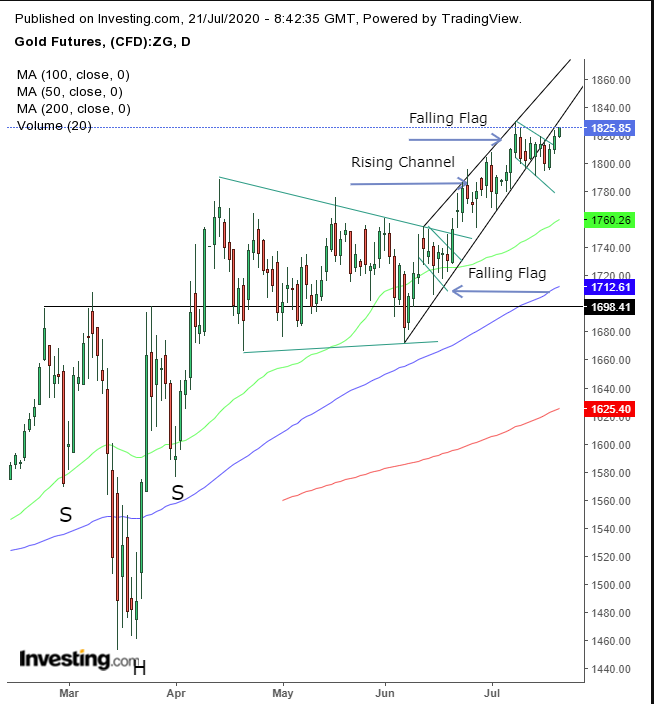
The yellow metal's price includes a two-day penetration above a falling flag, suggesting a continued rally. Its precious metal peer, silver, is perhaps, experiencing an even more powerful rally at the moment.
Oil reached $42 in mid-day trade.
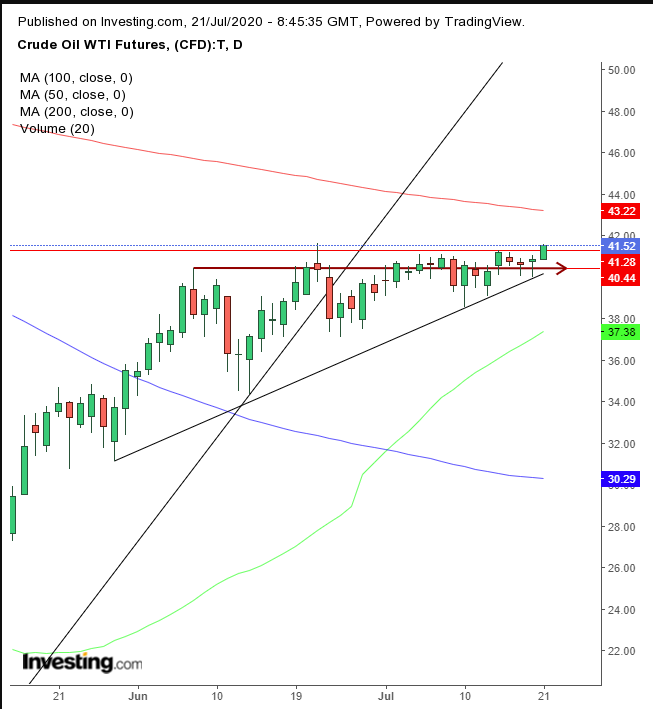
This is the first time since March 5 that WTI touched this level and it may be crossing the resistance formed by the March 9 falling gap that wiped out about a quarter of the value of the commodity. While the 200 DMA looms above, should prices hold, they may be breaking out of an ascending triangle, a bullish signal.
Up Ahead
- Quarterly earnings season picks up steam this week: reports this week will include Microsoft (NASDAQ:MSFT), Blackstone Group (NYSE:BX), Intel (NASDAQ:INTC), Unilever (NYSE:UL) and Mattel (NASDAQ:MAT).
- The EIA's crude oil inventories release is due Wednesday.
- U.S. weekly initial jobless claims print on Thursday.
Market Moves
Stocks
- The Stoxx Europe 600 Index increased 0.9%.
- Futures on the S&P 500 Index rose 0.5%.
- NASDAQ futures climbed 0.8%.
- The MSCI Emerging Markets Index gained 1.7%.
Currencies
- The Dollar Index climbed 0.1%.
- The euro ticked higher by 0.1% to $1.1462.
- The British pound gained 0.4% to $1.2709.
- The Japanese yen was little changed at 107.29 per dollar.
- The South Korean won strengthened 0.5% to 1,197.75 per dollar.
Bonds
- The yield on 10-year Treasuries increased less than one basis point to 0.61%.
- Germany’s 10-year yield gained one basis point to -0.45%.
- France’s 10-year yield rose less than one basis point to -0.163%.
- Britain’s 10-year yield decreased less than one basis point to 0.15%.
Commodities
- West Texas Intermediate crude climbed 0.5% to $41 a barrel.
- Gold strengthened 0.3% to $1,823.68 an ounce.
- Iron ore rose 2% to $108.20 per metric ton.
